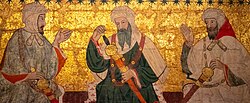
Back إمارة نكور Arabic إمارة نكور ARY Emiratu de Nekor AST Emirelezh Nekor Breton Nakur Catalan Emirato de Nekor Spanish Nekori Emiraat Estonian Nekorin emiraatti Finnish Émirat de Nekor French Tageldit n Nekkur KAB
Emirate of Nekor إمارة بني صالح | |||||||||
|---|---|---|---|---|---|---|---|---|---|
| 710–1015 | |||||||||
 The Emirate of Nekor (yellow) at the time of the Idrisid dynasty. | |||||||||
| Status | Client state of the Umayyad Caliphate (710–750) | ||||||||
| Capital | Tamsāmān (710–760) Nekor (760–1015) | ||||||||
| Common languages | Arabic Berber | ||||||||
| Religion | Islam | ||||||||
| Government | Monarchy | ||||||||
| Emir | |||||||||
• 710–749 | Şālih I ibn Mansūr | ||||||||
• 947–970 | Jurthum ibn Ahmad | ||||||||
| Historical era | Middle Ages | ||||||||
• Established | 710 | ||||||||
• Disestablished | 1015 | ||||||||
| |||||||||
| History of Morocco |
|---|
 |
| Historical Arab states and dynasties |
|---|
 |
The Emirate of Nekor or Şālihid Emirate (Arabic: إمارة بني صالح, romanized: ʾImārat Banī Ṣāliḥ) was an Arab emirate centered in the Rīf area of present-day Morocco. Its capital was initially located at Tamsāmān, and then moved to Nekor. The ruling dynasty presented itself as of Himyarite Arab descent.[1] The emirate was founded in 710 CE by Şālih ibn Mansūr through a Caliphate grant. Under his guidance, the local Berber (Amazigh) tribes adopted Islam, but later deposed him in favor of one Dāwūd al-Rundī (unlikely to have been a native of Ronda) from the Nafza tribe. They subsequently changed their mind and reappointed Şālih ibn Mansūr.[2] His dynasty, the Banū Şālih, thereafter ruled the region until about 1015.
Several successive political entities controlled the Rīf In the period between the 8th and 14th centuries. The Emirate of Nekor, established at the beginning of the 8th century, ended with the destruction of its capital city Nekor in 1080. The area was integrated subsequently into the dominions of the Almoravids, and then those of the Almohads and the Marīnids.[3]
The Emirate of Nekor (or Nakūr) was the first autonomous state in the Maghreb and the only one that adhered to Sunni Islam exclusively. Not much is known about the town of Nekor's archaeology outside the field survey and minor excavations conducted in the 1980s. The town has what may have been a mosque, a possible hammam, or public bathhouse, and two substantial walls. Ceramics excavated there include local productions and others that show its connections with Ifrīqya and al-Andalus.[4]
- ^ Picard, Christophe (2018). Sea of the Caliphs. Harvard University Press. p. 247. ISBN 978-0-674-66046-5.
- ^ Cite error: The named reference
Pellat1993was invoked but never defined (see the help page). - ^ Coletti, Caterina Maria (1 November 2018). "Risultati e aspetti problematici della ricerca archeologica a Melilla e nel Rif (Marocco settentrionale)". Antiquités africaines. L’Afrique du Nord de la protohistoire à la conquête arabe (in Italian) (54): 37. doi:10.4000/antafr.966.
- ^ Anderson, Glaire D.; Fenwick, Corisande; Rosser-Owen, Mariam (2017). "Introduction". In Anderson, Glaire D.; Fenwick, Corisande; Rosser-Owen, Mariam (eds.). The Aghlabids and their Neighbors: Art and Material Culture in Ninth-Century North Africa. BRILL. p. 27. ISBN 978-90-04-35604-7.
© MMXXIII Rich X Search. We shall prevail. All rights reserved. Rich X Search